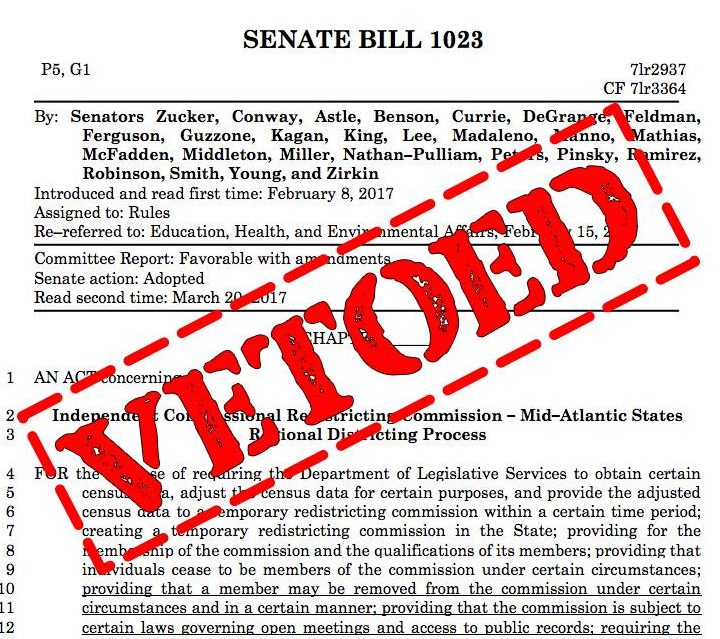By Len Lazarick
Democrats were quick to jump on Republican Gov. Larry Hogan for vetoing their version of alleged redistricting reform on Monday.
The state party accused Hogan of pushing “a partisan redistricting plan that would help himself and Donald Trump pick up more votes in 2018 and 2020.”
The charge is inaccurate since the independent commission that Hogan wants to draw congressional and legislative districts doesn’t start operating until 2021, the year after the 2020 census provides new population figures.
In a joint statement, House Speaker Michael Busch and Senate President Mike Miller claimed that “Hogan prefers his plan to simply elect more Republicans to Congress,” rather than their own “nonpartisan solution.”
It is highly likely that under Hogan’s independent commission at least one more Republican from Maryland would get elected to Congress. An independent nonpartisan commission is designed to draw lines that don’t screw Republican voters the way the Democrats have.
Hogan achieves this dastardly deed by completely giving up the power he currently has to draw districts lines, and his bill takes it away from Busch and Miller as well.
Essentially the presiding officers make the very Zen-like charge that Hogan is helping his party gain political clout by giving up his power to draw the lines.
It doesn’t make much sense.
Nor does the Democrat Party’s claim that “Democrats want to make the state a national leader on redistricting reform.” They do that by insisting that five other states go along with their plan for drawing congressional lines before Maryland acts.
That’s the kind of leadership shown by the drunk at the bar who says he’ll give up drinking if his five other drunken bar mates give up booze at the same time.
A campaign issue
Hogan held a very public veto of the Democrats’ proposal, a dramatic gesture he has not done before. That makes clear he has decided to make the issue part of his 2018 reelection campaign. Hogan likes to be on the right side of public opinion.
The governor has held more press conference on redistricting reform than he has for most of his priorities, other than transportation projects — another issue he will pound home in his campaign next year.
Hogan is also tying redistrict reform to ethics reform at the State House, which has recently seen the indictment of three Democrats who served as delegates.
In 2015, Hogan appointed a commission to study the redistricting process co-chaired by retired Federal District Court Judge Alexander Williams, an African American and a former Democratic state’s attorney, and Republican Walter Olson. Through months of meetings and hearings and work sessions — covered ad nauseam in MarylandReporter.com — they came up with a complicated plan that totally removes elected officials from drawing the lines that has left just one Maryland Republican in Congress.
In 2016, the legislature did nothing with Hogan’s proposal. In 2017, it was killed in the House Rules committee dominated by Democratic leaders. Instead Democratic legislators lifted half the language from Hogan’s bill, left out the parts that most affected themselves, and added the never-going-to-happen provision about the multistate compact.
Comparing the bills
Here’s how the two bills compare on other issues.
No elected officials, no relatives of elected officials, no one who has run for elected office, no lobbyists, and no one who has given more than $2,000 to a political campaign could serve on the nine-member commission in Hogan’s plan. The members would be chosen by legislative auditors reviewing resumes and then drawing nine names out of a hat, not by the governor.
The Democratic plan excludes the same people as in the governor’s bill but politicians still appoint the members. Their nine-member commission has two members each appointed by the speaker, the Senate president, and the minority leaders of both houses, and a chairman chosen by the other eight.
The biggest difference between the two proposals is that Hogan’s bill covers both legislative and congressional districts. The Democrats’ plan only covers congressional districts. The current political process for drawing lines for the General Assembly would remain in place.
The Hogan plan also changes how much the population can vary in legislative districts from 10% to 2%. Under the current system, legislative districts in Democratic areas can be 10% under the ideal size, and other districts which usually elect Republicans can be 10% larger than ideal. This means that in some cases a Republican legislator represent 20% more people than some Democrats in the legislature.
The Democrats plan uses the same criteria for drawing the lines as in the governor’s bill. They must follow federal law, be compact and contiguous and recognize geographic, county and municipal boundaries. The commission may not consider where incumbents live or the partisan make up of the population.
The main gripe
The Democrats’ main complaint is that they do not want to “unilaterally disarm” when so many Republican states have gerrymandered districts to help them get and maintain control of the U.S. House of Representatives. Half the states are now controlled by Republican governors with Republican legislatures. Democrats control only five. In 2010, they had full control of 17 states.
Ultimately, Maryland’s Democratic leaders care more about regaining power in Congress than being fair to constituents who disagree with them.
Even without the just-for-show multistate compact, the Democrats’ bill only goes half way to reforming partisan gerrymandering in Maryland. There are some problems with Hogan’s bill, but they are all fixable. Democratic legislators don’t truly want to fix anything about the current process, but want to pretend that they do.




Recent Comments